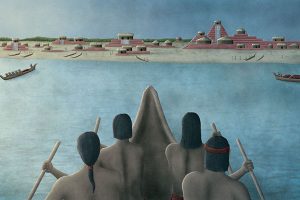The Hidden Coastal Culture of the Ancient Maya
By Erik Vance / Hakai Magazine
For thousands of years, ancient Maya kings ruled a vast inland empire in Mexico and Belize. But just how inland was it, really?

The Maya culture is often associated with farming and extraordinary inland cities full of fascinating architecture. New research, however, shows that the people were also sophisticated mariners. Illustration by Mark Garrison
Vista Alegre, a ruin of a town near the northern tip of the Yucatan Peninsula in Mexico, was once a bustling outpost. Dozens of canoes crowded the harbor, loaded down with dyes from the west, jade from the south, and obsidian from mountains hundreds of kilometers away. The sound of trumpeting conch shells periodically sliced the air—an alert from sentries scanning the horizon from platforms attached to stone structures. The call signaled an incoming boat—to trade or, perhaps, to plunder.
Within the town, the smell of fish hung heavy in the air as fishermen hurried about with their catches slung across their backs. They passed a man outside his hut hacking a pile of decorative shells into portable sizes for the next outgoing canoe. In another hut, a woman was using salt from a town to the south to dry freshly caught fish that would then be shipped to cities far away. And all the while, smoke from a signal fire atop a pyramid guided exhausted ocean travelers to safe harbor.
Today, a thousand years later, the town isn’t much to look at. Centuries of accumulated dirt and vegetation cover the pyramids. Trees growing on various structures have succumbed to gravity, tumbling and taking with them massive stone blocks once perfectly fitted together.





